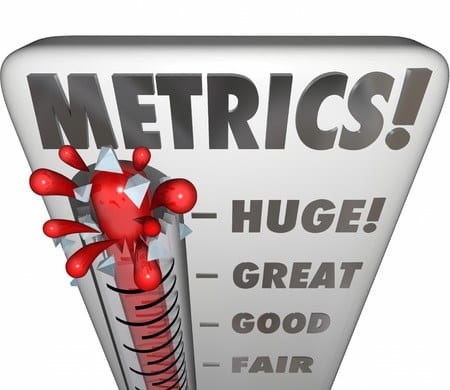Separating ROI from data noise
 Learn what metrics can help you truly understand the value of your spend, and what technologies really deliver on this most important metric.
Learn what metrics can help you truly understand the value of your spend, and what technologies really deliver on this most important metric.
Small-to-medium businesses are investing in their marketing at jaw-dropping new levels. BIA/Kelsey predicts that 2015 will be a banner year for local media expenditure on the part of these organizations, with investment exceeding $50 billion. Digital investments are at the forefront, with 28% of marketers reducing their traditional advertising budget to fund more digital marketing and search marketing capturing the largest share of online spend at 47%, according to Business2Community. But with so many dollars on the line, how can a business know what investments are really paying off?
Return on Investment is the gold standard that today’s marketers are seeking. But with each new media channel, there is new complexity in the metrics used to calculate ROI. A couple of examples:
PPC Metrics
Pay-Per-Click (PPC) advertising has 8 typical Key Performance Indicators (KPIs) to track the effectiveness of campaigns, including:
- Impressions: How many times an ad is shown
- Quality Score: A search engine’s calculation of ad copy relevance to keyword or query
- Clicks: How many times someone clicks on an ad
- CPC: Cost per click
- CTR: Click through rate
- CPA: Cost per acquisition
- Conversion Rate
- Total Spend
Social Media metrics
Social media metrics include reach and engagement, in addition to platform specific metrics, including:
- Likes
- Followers
- Shares
- Retweets
All of this data can cause a marketer’s head to spin. Many SMBs and their marketers are asking:
- 'In my social media, should I focus more on reach or on how many likes a promoted post has gotten?'
- 'Are shares more important?'
- 'Is Click-through-rate what I’m worried about, or conversions?'
Answering these questions involves making sense of a kaleidoscope of new and evolving metrics. Many online marketing products couple their campaign platforms with dashboards in order to help business owners visualize the results they are trying to comprehend. But what this often becomes is confusing noise that makes a simple ROI calculation more difficult. Without a straight answer as to which marketing investment is paying off, marketers and the companies they work with are less likely to open their wallets to more advertising.
How to rise above the noise
There is one clear metric that, regardless of the media channel, provides a simple way to begin calculating the elusive advertising ROI.
This metric can be measured the same way regardless of campaign, whether social media, search marketing, even a simple print ad. Think of this metric above all else: Lead Acquisition Cost (LAC).
Why is LAC so effective at connecting results to efforts? Because it focuses not on a click or a 'Like', but an actual prospect engaging with a business. Similar to Cost Per Lead (CPL) or Price Per Lead (PPL), it’s basically a business’s calculation and qualification of the amount paid for each lead, of any form, that a business receives.
It’s calculated by taking the cost of all investments in lead-generating campaigns and dividing that cost by the new leads acquired during a fixed amount of time.
For the purposes of this calculation, you should only count what some marketers call qualified leads. Qualified leads reflect the number of leads that were actually in the market for services or products your company provides. If you’re having a hard time figuring out how to qualify leads coming in, then focus on total leads for now. Once you begin to calculate LAC, your appetite for refining the data will grow along with your understanding of how to do it.
Affordable LAC tracking
It used to be more difficult for a small-to-medium business to track their own LAC, but new tools are available that are making it easier. These tools are tracking lead engagement at a much lower point in the marketing and sales funnel than the typical platform-specific metrics mentioned above. Knowing how many times an ad is clicked is much less helpful in calculating LAC than lower funnel metrics like appointments booked, in-store traffic, and phone calls from first time callers.
Tools such as call tracking analytics use a phone number assigned to a specific keyword, ad or campaign when a customer is calling a business as a result of a specific marketing effort. Since these numbers can be assigned and inserted into a campaign anywhere, the lack of platform-specific tools that measure lower funnel activity is irrelevant.
There’s also been significant growth in other low-funnel services like in-store beacons and appointment booking software over the past year, as well as dashboard software that connects to these applications. Even old technologies like people-counting devices at retail stores are seeing an uptick.
What do these changes mean for the marketer seeking ROI? It means you can gain LAC data without an expensive, complicated effort.
While data is the key to insight, too much noise in the data renders it useless. By focusing on LAC, you can streamline your analytics to a point that they are truly meaningful. The result will be a solid picture of what marketing investments are paying off, what expenses need to be trimmed, and what efforts might need to be abandoned completely.

Thanks to
Mark Sullivan for sharing his advice and opinions in this post. Mark is the Director of Analytics at
CallRail, and inbound call tracking platform. You can follow him on
Twitter or connect on
LinkedIn.



 Learn what metrics can help you truly understand the value of your spend, and what technologies really deliver on this most important metric.
Learn what metrics can help you truly understand the value of your spend, and what technologies really deliver on this most important metric. Thanks to
Thanks to 



